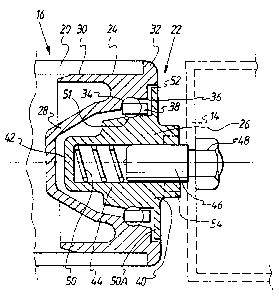Une partie des informations de ce site Web a été fournie par des sources externes. Le gouvernement du Canada n'assume aucune responsabilité concernant la précision, l'actualité ou la fiabilité des informations fournies par les sources externes. Les utilisateurs qui désirent employer cette information devraient consulter directement la source des informations. Le contenu fourni par les sources externes n'est pas assujetti aux exigences sur les langues officielles, la protection des renseignements personnels et l'accessibilité.
L'apparition de différences dans le texte et l'image des Revendications et de l'Abrégé dépend du moment auquel le document est publié. Les textes des Revendications et de l'Abrégé sont affichés :
| (12) Brevet: | (11) CA 2099244 |
|---|---|
| (54) Titre français: | PALIERS POUR ROULEMENTS A BILLES ET ANALOGUES |
| (54) Titre anglais: | BEARINGS FOR ROLLERS AND THE LIKE |
| Statut: | Périmé et au-delà du délai pour l’annulation |
| (51) Classification internationale des brevets (CIB): |
|
|---|---|
| (72) Inventeurs : |
|
| (73) Titulaires : |
|
| (71) Demandeurs : | |
| (74) Agent: | |
| (74) Co-agent: | |
| (45) Délivré: | 2002-08-20 |
| (86) Date de dépôt PCT: | 1992-01-14 |
| (87) Mise à la disponibilité du public: | 1992-08-06 |
| Requête d'examen: | 1998-08-18 |
| Licence disponible: | S.O. |
| Cédé au domaine public: | S.O. |
| (25) Langue des documents déposés: | Anglais |
| Traité de coopération en matière de brevets (PCT): | Oui |
|---|---|
| (86) Numéro de la demande PCT: | PCT/GB1992/000070 |
| (87) Numéro de publication internationale PCT: | WO 1992013204 |
| (85) Entrée nationale: | 1993-06-25 |
| (30) Données de priorité de la demande: | ||||||
|---|---|---|---|---|---|---|
|
A roller bearing comprises inner and outer cup-shaped members (24, 26) which
interfit and respectively have races (34, 51)
on which balls run enabling the members (24, 26) to rotate one relative to
another. The outer cup shaped member (24) is for plug-
ging into the end of a roller sleeve (20) to seal the interior thereof from
moisture ingress.
Note : Les revendications sont présentées dans la langue officielle dans laquelle elles ont été soumises.
Note : Les descriptions sont présentées dans la langue officielle dans laquelle elles ont été soumises.

2024-08-01 : Dans le cadre de la transition vers les Brevets de nouvelle génération (BNG), la base de données sur les brevets canadiens (BDBC) contient désormais un Historique d'événement plus détaillé, qui reproduit le Journal des événements de notre nouvelle solution interne.
Veuillez noter que les événements débutant par « Inactive : » se réfèrent à des événements qui ne sont plus utilisés dans notre nouvelle solution interne.
Pour une meilleure compréhension de l'état de la demande ou brevet qui figure sur cette page, la rubrique Mise en garde , et les descriptions de Brevet , Historique d'événement , Taxes périodiques et Historique des paiements devraient être consultées.
| Description | Date |
|---|---|
| Inactive : CIB de MCD | 2006-03-11 |
| Inactive : Lettre officielle | 2005-07-26 |
| Inactive : Lettre officielle | 2005-07-26 |
| Exigences relatives à la révocation de la nomination d'un agent - jugée conforme | 2005-07-26 |
| Demande visant la révocation de la nomination d'un agent | 2005-06-08 |
| Le délai pour l'annulation est expiré | 2004-01-14 |
| Lettre envoyée | 2003-01-14 |
| Accordé par délivrance | 2002-08-20 |
| Inactive : Page couverture publiée | 2002-08-19 |
| Inactive : Taxe finale reçue | 2002-06-03 |
| Préoctroi | 2002-06-03 |
| Lettre envoyée | 2002-05-13 |
| Un avis d'acceptation est envoyé | 2002-05-13 |
| Un avis d'acceptation est envoyé | 2002-05-13 |
| Inactive : Approuvée aux fins d'acceptation (AFA) | 2002-04-29 |
| Modification reçue - modification volontaire | 1999-01-19 |
| Inactive : Acc. réc. RE - Pas de dem. doc. d'antériorité | 1998-10-02 |
| Inactive : Renseign. sur l'état - Complets dès date d'ent. journ. | 1998-09-30 |
| Inactive : Dem. traitée sur TS dès date d'ent. journal | 1998-09-30 |
| Exigences pour une requête d'examen - jugée conforme | 1998-08-18 |
| Toutes les exigences pour l'examen - jugée conforme | 1998-08-18 |
| Demande publiée (accessible au public) | 1992-08-06 |
Il n'y a pas d'historique d'abandonnement
Le dernier paiement a été reçu le
Avis : Si le paiement en totalité n'a pas été reçu au plus tard à la date indiquée, une taxe supplémentaire peut être imposée, soit une des taxes suivantes :
Veuillez vous référer à la page web des taxes sur les brevets de l'OPIC pour voir tous les montants actuels des taxes.
| Type de taxes | Anniversaire | Échéance | Date payée |
|---|---|---|---|
| TM (demande, 6e anniv.) - générale | 06 | 1998-01-20 | 1998-01-12 |
| Requête d'examen - générale | 1998-08-18 | ||
| TM (demande, 7e anniv.) - générale | 07 | 1999-01-14 | 1998-12-30 |
| TM (demande, 8e anniv.) - générale | 08 | 2000-01-14 | 1999-12-08 |
| TM (demande, 9e anniv.) - générale | 09 | 2001-01-15 | 2000-12-12 |
| TM (demande, 10e anniv.) - générale | 10 | 2002-01-14 | 2001-11-29 |
| Taxe finale - générale | 2002-06-03 | ||
| TM (demande, 2e anniv.) - générale | 02 | 1994-01-14 |
Les titulaires actuels et antérieures au dossier sont affichés en ordre alphabétique.
| Titulaires actuels au dossier |
|---|
| BNL LIMITED |
| Titulaires antérieures au dossier |
|---|
| DAVID MORRIS GARNETT |